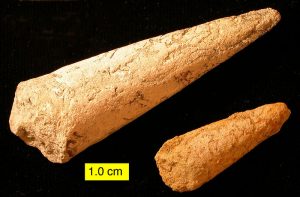The Wikipedia pages on bivalves and oysters are good, and there is a Wooster touch on each. Here is a nice webpage with some simple anatomical diagrams of bivalves. (A useful page for our dissections in lab this week.) Don’t miss this site on Ohio’s favorite bivalve, the Zebra Mussel. This is a simple index to the common bivalve families, with images which will be helpful in lab. The Monterey Bay Aquarium Research Institute has some good photographs of deep-sea bivalves and other marine invertebrates.
Hyoliths are mysterious and inconveniently extinct. We are not considering them mollusks here, but an outgroup to which we can compare mollusks for evolutionary purposes. We don’t know much about them, as you can see from that brief Wikipedia page (but with great images you’ll recognize!). We have some specimens, though, for your entertainment in lab. [Update! Hyoliths are now placed among the lophophorates.]
The evolution of mollusks is a much larger story, of course, and there are some very new studies in the field. Note that the linked article has a classic line: “The results from the genetic analysis show the paleontologists were right.” This means what I have been teaching for decades, for once, I don’t have to modify (much). The Wikipedia section on molluscan evolution is still pretty sketchy (literally), but there are some useful diagrams. You will want to meet the odd aplacomorphan mollusks before our lecture. They have virtually no fossil record, but are critical to the evolutionary scenario.
Here again is a short and good video summary of some molluscan adaptations. It is well done.
Your second lecture test is on Thursday, November 2. Here is an example: the 2016 second paleo test.

Hyoliths from the Middle Ordovician of northern Estonia.
Geology in the News –
Geological processes on Mars! Check out how the annual freeze-thaw cycles on Mars produce changes in sand dunes. Mars is not nearly as dynamic as Earth when it comes to modern processes, but it was back in the day. No fossils on Mars, though. Yet.
Back on Earth, three scary new studies show that sea levels may be rising faster and higher than we thought. Hold off on buying that cute little cottage on the shore — a new shore is coming. (And I’d avoid moving to Miami.)
Here’s a good analysis in The New York Times on concepts of skin color, race and genetics. You know some of the basic principles here.
